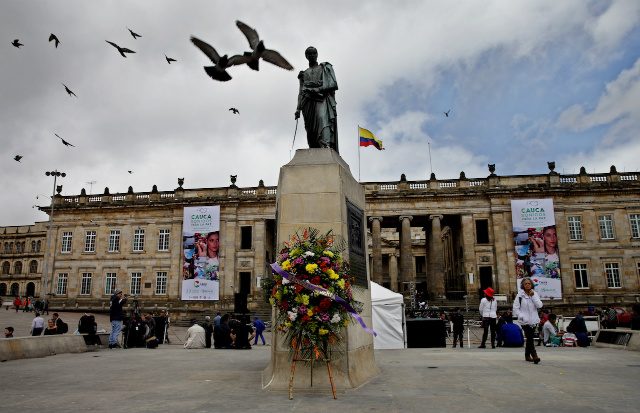SUMMARY
This is AI generated summarization, which may have errors. For context, always refer to the full article.

BOGOTA, Colombia – Some 400 UN personnel will monitor a disarmament deal ending Colombia’s civil war and courts will rule in July whether a referendum can be held to endorse the ceasefire, officials said Friday, June 24.
The announcements came a day after the Colombian government and the country’s biggest rebel force, the FARC, signed a definitive ceasefire agreement, one of the last steps toward ending the half-century conflict.
The next step will be to sign a full peace agreement, which will launch a 6-month UN-monitored disarmament process.
Foreign Minister Maria Angela Holguin told Radio Caracol that at least 400 UN observers would come to monitor the demobilization and disarmament. She said she expects the United Nations to fund the operation.
The estimated 7,000 members of the Revolutionary Armed Forces of Colombia (FARC) will gather in 23 “normalization zones” for demobilization.
Analysts cautioned that several other points of discussion remain to be settled between the two sides, including how to reintegrate FARC members into civil and political life.
The sides also have yet to agree on where the final deal would be signed.
The government wants it to happen in Bogota while the FARC prefers Havana, where the peace talks have been hosted.
“Some points remain to be negotiated, but it seems clear after yesterday’s signing that there will soon be a final accord,” said Arlene Tickner, an international relations expert at the University of the Andes in Bogota.
The 180-day deadline for disarmament “seems a relatively short time,” she however noted.
Full peace deal close
President Juan Manuel Santos said ahead of the signing on Thursday, June 23, that he hoped for a full peace deal by July 20, though the timing remained unclear on Friday.
Holguin said the signing of the final agreement was “very, very close.”
She said the constitutional court was expected to rule “around the beginning of July” on the government’s call for a referendum.
In their ceasefire accord sealed Thursday, Santos and FARC rebel chief Timoleon Jimenez promised to abide by the court’s decision.
If a referendum does take place, it would be a symbolic gesture that would take place after the signing of the final peace deal.
It was not clear what would happen if Colombians rejected the deal in a referendum after it was signed.
Once the peace deal with the FARC is passed, the government will turn to planned peace talks with the country’s second-biggest rebel group, the leftist National Liberation Army (ELN).
It must also carry out its pledge under the ceasefire to tackle the paramilitary groups and drug gangs that have aggravated the conflict.
“The paramilitaries are the main threat to the accords,” FARC negotiator Pablo Catatumbo told reporters in Cuba where the ceasefire was signed.
The Colombian conflict started in the 1960s as a rural uprising for land rights that spawned the communist FARC.
The fighting has drawn in various leftist rebel groups, right-wing paramilitaries and drug gangs over the decades.
It has left 260,000 people dead, 45,000 missing and nearly 7 million displaced, according to official figures. – Rappler.com
Add a comment
How does this make you feel?
There are no comments yet. Add your comment to start the conversation.